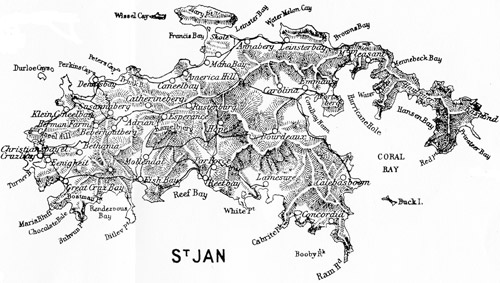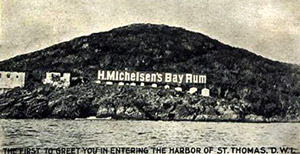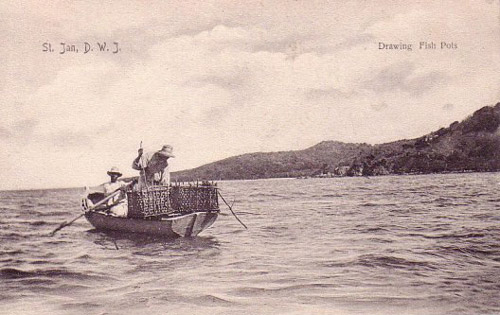A Week on St. John (Notes from Denmark’s most beautiful island)
(Translated from an article in Gads Danske Maqasin, March 1914, by Leif Calundann Larsen. Olaf Linck [1874-1958] was a prominent Danish journalist and novelist. Members may recall his article “Christmas Eve Aboard the Ingolf” which appeared in our December 2007 newsletter.)
During my second journey to the West Indies in the winter of 1912-13, I had sufficient time to accept an invitation to visit the smallest of the Danish West Indian Islands, the most beautiful and neglected of them all: The stepchild of St. John.“You will probably return tomorrow”, some prosaic gentlemen of St. Thomas exclaimed, wishing me a pleasant journey with skeptical smiles. But I remained there for a week, and it was so difficult tearing myself away from the adventure implied in the name of St. John that I wished I could have stayed longer.Though the island is situated close to St. Thomas, its bigger brother, the journey over there is still a bit of an expedition. Incidentally, these two islands share the same Colonial Council, while St. Croix, 10 Danish miles away, has its own Council. The man I was to visit sent his boat to St. Thomas to pick me up. It was manned by three, young, strong Negroes, of whom the “captain” came to the hotel to hand me a letter, in which my host advised me to bring along provisions, as we would not arrive at our destination until late in the day.

1907 map of St. John from Dansk Vestindien 1666-1917 by Kay Larsen
The morning sun was just rising over the mountains as our boat drifted out through the spacious harbor. There was no wind to catch at all. The captain stood whistling on the thwart. It was an odd, melancholy hissing between his teeth that his helpers repeated like an echo. He looked so serious and ceremonious that I asked: “Why do you whistle?” “We call the wind”, he quietly answered. “Does it come, then?” “Usually”, the black man replied with the same serious tone.Indeed, a little later we actually perceived a breeze, the dead calm water rippled, and having rounded the lighthouse the sails caught all the wind that could fill them. Unfortunately, the wind was against us, so we had to beat against it. Each time the boat went about I had to lie down in the bottom to keep my head out of the boom’s way. Finally, I just stayed down, trying to tell myself that it was not worth the trouble to change position every minute. However, as a cup of tea and two rather soft eggs had been swimming around in my interior long enough, I had to get up. It was an embarrassing situation. No, I would prefer a storm in the Atlantic Ocean! How supercilious you are when you are on a steady deck. I suddenly realized that nemesis had revenge on me here in the strait between St. Thomas and St. John. After beating uneventfully against the wind among small rocks and islands for three long hours, we reached Cruz Bay on St. John. Here my host awaited me with horses, but before making for his home on the opposite end of the island, we naturally had to visit the island’s only Danish white man, Dr. Winkel, St. John’s physician and police superintendent.There are only 2 white men among approximately 950 inhabitants on the island and the other white man lives in Emmaus, the church town and the capital. He is a young Englishman and Moravian minister. The two young men are, by the way, both married to white women from their homelands, and in their homes small white children run about the rooms. Little, half-wild white children with big, amazed eyes.Doctor Winkel lives in the picturesque, timeworn Administration building, which, situated on a palm-covered spit of land, is reflected in the crystal clear water. You can sit on its gallery and watch the sharks glide in and out of the bay like dark, furtive shadows. The little bathing pool below the house is carefully fenced in.The doctor’s family welcomed us with transports of joy, which soared because we had brought along some ice. A while later the house echoed with the sounds of cocktail mixing. This delicious but treacherous drink is prepared in the West Indies according to countless recipes. There are men here whose fame rests entirely on their ability to mix a heady cocktail!Eventually we mount our horses and commence our ride across the island. At first the road is so broad that carriages could pass, if such means of transport still existed on St. John. But, they belong to a golden past. After some hundred meters the road narrows into a footpath. Thereafter, we ride continuously through the forest, at first a low thicket, then tall trees, a magic wood where the vegetation alternates with an imaginative vigor. Frequently we pass sugar factory ruins, the remnants of slave days. The walls still stand, but palms have grown up between them and it seems as is if the plants have pushed off the roofs. White and blue flowers strike our cheeks. Yellow guava fruits delight the eye. We seldom see a negro but as we ride up and down steep mountain paths. The horse, which knows the way and the rocks, does not once stumble as it crosses murmuring creeks in the valleys and wades through meter- high grass.On the mountain tops we pause to enjoy the impressive views. Around and below us we see a green carpet of wood, and in the distance are indented bays with chalk white beaches that almost strike sparks from the sun. About the island we see green, rocky islets, where humans neither live, nor have ever been. Finally, there is the infinite sea, on which you can just make out the misty outlines of St. Croix. It is a treat to see steamer smoke rising in the distance.It is almost most sunset when we reach our destination beneath Bordeaux Mountain, the “Lamesure” plantation whose owner is Chamberlain H. Grevenkop-Castenskjold, the Danish Ambassador to London. The plantation is managed by Mr. White, a native St. Johnian, who takes pride in having cleared and planted 100 acres for the owner, who visits the island only at intervals of several years. Practically the whole of St. John is overgrown with bush, where only a few generations ago there were sugarcane and cotton fields.

Chamberlain Grevenkop-Castenskjold is one of the few in our time who has bought land on St. John in order to cultivate it. Here on “Lamesure” it has been the practice to clear the bush and plant bay trees and lime trees. The bay tree, which is the most important planting, requires some comment. It is a slim tree, usually 7-8 meters high, with many coriaceous leaves that are stripped off and then pressed. After the bay oil has been manufactured by pressing it, it is diluted with alcohol to produce the famous bay rum. In the heat the refreshing qualities of bay rum are highly prized, while a bath infused with it is like a rejuvenation treatment. However, the claim that the Negroes drink the bay rum is incorrect. Bay rum has become a major export article, in particular to the United States and Central America. It is the article first offered to steamers calling at St. Thomas, and signs of competing bay rum merchants are the first thing you see entering the harbor. On St. John the bay tree grows wild in the forest, but on “Lamesure” it is cultivated and is said to be a good business. It is a fact that the best bay rum in the West Indies comes from St. John.Although bay trees and lime trees are the most important plantings on St. John, it should be mentioned that coconuts bananas, oranges and sweet potatoes are also cultivated and a little coffee and cocoa have been tried out. On the entire island only about three or- four- plantations are being systematically operated. One of these is “America Hill”, owned by a Danish Company that is going into cattle breeding. For some years they have experimented with cross-breeding native cattle with Danish or English breeds, and the issue seems to thrive. Cattle breeding on St. John should prosper, for when St. Thomas becomes a port of international importance it wi 11 need large amounts of fresh meat, which St. John and St. Croix are capable of producing. The planters of this little island are quite rightly concerned with current and planned harbor improvements on St. Thomas.On St. John I spent the days riding from sunrise to sunset. Mr. White was tireless in taking me all over the island. We rode to the church service at Emmaus, where almost all the island’s residents gather on Sundays. We also visited the famous Carib inscriptions that are the only visible relics the aboriginal inhabitants. Neither wind nor water has been able to obliterate these mysterious signs and figures that the Indians hewed out of the rocks on the mountain now called Dublin Hill. A negro cleared a path for the horses through the wilderness surrounding the rock, which goes unfrequented for years. There is a temple-like atmosphere about it; the only thing breaking the silence is the noise made by the wings of a humming bird, as it, insect like, drinks from a flower on the rock. On Saturdays, when work on land is suspended, most of the island’s able men sail out to fish, and usually return with their boats full of fish all colors of the rainbow. When these fish are salted, there is food in the hut for most of the week.The day is too short. The incomparable bath on the deserted beach occupies one hour each morning and evening, and the incursions into the wood cannot go far enough. There is always something new to see: a new flower, a new berry, a new tree, a new songbird; half-wild cattle and half-broken, small, hairy horses. Gorgeous peacocks, imported by Chamberlain Grevenkop-Castenskjold some years ago, have multiplied so much that you can meet them wild in the woods, where their shrill screams echo through the mountains.The most widely distributed animal of St. John is the mongoose, a snappish, little carnivore that was introduced in the past to exterminate the rats. However, this objective failed, presumably because the mongoose found it much easier to hunt wildfowl and chickens, the latter of which are a fair way to disappearing from St. John.

Postcard c1909 ‘Drawing Fish Pots’ by J. Lightbourn.
The short evening could appear to be long. The sun sets about six o’clock year round and darkness falls quickly. Then you sit down with your host and hostess on a veranda that is surrounded by many green plants on whose leaves the beautiful lizards sit immovable as if they were cast iron, seemingly listening to the human conversation. Just ahead we know is the dark sea, and behind us are the mountains. If it happens during the evening that a navigation light glides past in the darkness, it is felt like a gleam from another world.The night – well, the night was indeed overwhelming and long. We bade good-night at 8 o’clock and took to bed behind the mosquito net in order to rest saddle sore limbs. You lie on the bed, not in it. At the very utmost you are covered by a sheet. Because the night is sultry all windows are open and the sweet, intoxicating fragrance of jasmine sweeps through them. The star jasmine grows vigorously in the tangle near the house that hides the old “Lamesure” cemetery. Each plantation on the Island has its own burial ground. The dead are the only souls on St. John not conveyed by horse. When someone dies they are, preferably on the same day, buried in the ground outside their home. The fragrance of Jasmine mingles inseparably with the eternal jingle of cicadas. The whole mountain sings and you fall asleep with the feeling that nature has embraced you. What infinite peace! And, when you awake in the darkness, because you are not used to such a long night, the feeble song of the cicadas lingers on and ceases only when sunrise puts night dreams to flight.Yes, the island of St. John is a dreamland. But how long will the dream continue? When will it learn from the nearby English island of Tortola, which is like one great flowering garden, in whose soil (which is not more endowed by nature than St. John) is cultivated coffee, cotton, limes, oranges, bananas and many other kinds of fruit. Several years ago Doctor Fishlock, an agronomist, established an experimental station on Tortola with government support. It was similar to the one established on St. Croix and managed by Doctor Longfield Smith. However, while the latter has not been entirely successful in establishing contact with the planters, that on Tortola has become the island’s cornerstone. The Negroes learn to cultivate their land, and, more importantly, the agricultural products are sold for them by the station, which only exacts a minor charge for the station’s maintenance.Governor Helwig-Larsen has long been aware of the possibilities of St. John. Previously, during a stay in Denmark while Government Secretary, he tried to interest the Danish nobility and landowners in St. John, arguing that it would be a worthwhile task for these men to acquire and cultivate land on the island. So he invited them to a meeting on Zealand where the idea could be discussed; but those he had counted on did not attend, so the matter was shelved. Since then several projects have been considered. One plan was to send out about twenty Danish farmers, but how to guarantee that those to be sent were of the right stamp. Life on St. John, with its enchanting remoteness from the outside world, is quite different from that of Denmark, where neighbors can always be called upon. Another plan was to tax the uncultivated land of St. John, while reducing taxes on cultivated land. It was argued that this would encourage the many absentee owners on St. Thomas to sell off their properties. But, other forces came into play that proved stronger than the proponents of this excellent scheme. The Colonial Council, at least, doesn’t feel the time is right for such experiments.It is strange to imagine that a pearl like St. John, so gifted by nature and blessed with a mild, refreshing climate, might soon be “discovered”, not by Danes, but by far-sighted Americans. A luxury hotel on top of the island would have every prospect of transforming it from a Sleeping Beauty into a flourishing Caribbean tourist Mecca. In the last decade the southward flow of wealthy American tourists has progressed by leaps and bounds. The Danes must take good care of St. John while it still rests with them to control its destiny.A notice in the newspaper encouraged me to write these lines. It is reported that Lady Daisy Grevenkop–Castenskjold, a daughter of Count Mogens Friis, had gone to St. John to spend the winter at her husband’s estate “Lamesure”. The ambassador’s young wife is so enchanted with St. John’s nature that she has decided she would like to live there forever. Thus, the little, densely wooded island in the sea bewitches every new visitor, making another lifetime friend. Why not go out there yourself instead of your usual trip to the everlasting Riviera. Adventure awaits you on St. John.
See the related items:
[Way of life][Way of life]

